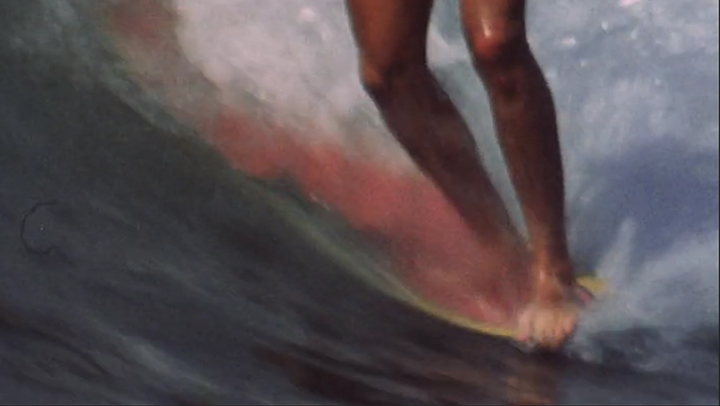MY INTRODUCTION TO NOSERIDING
At the beginning of 1962, I was 14 years old and riding my first board, which I got for Christmas. It was a tanker, 9’2″ and 19″ wide, solid Balsa wood board, painted white. I remember I could get my arm around it, but it weighed a ton, so I carried it on my head, making it easier to balance and walk. Still, I had to bunch up my towel and put it on top of my head first, then the board on top of the towel; otherwise, my head would eventually hurt if I had to carry it too long.
Despite the weight, I could catch many waves, get up to my feet, turn the board in the direction I thought it needed, and eventually learn how to walk up to the nose.
On the weekends, my mom took me to Sunset Beach in the Pacific Palisades, the point break at the end of Sunset Boulevard. Sunset was the first point-break north of the beach breaks in Santa Monica Bay. Like all the point breaks heading north, Sunset point has a cobblestone bottom, which made the wave shapes consistent for the most part. So, the waves became somewhat predictable, and thus, you could plan to do tricks, like spinners, standing on your head, and walking up to the nose. There were two main breaks at Sunset, one at the point and the other inside. My buddies from Emerson Junior High School and I surfed a lot on the inside.
We didn’t have leashes back then, so if you fell off or bailed out (jumping off the board intentionally) and didn’t grab your board in time, it would most likely get carried in with the wave, sometimes into shore. Also, unfortunately, the board would probably bump off the rocks and get damaged (“dung” or “dinged”), especially if it was low tide and the rocks were exposed.
After seeing Lance Carson ride the nose in the surf movies we’d see on the weekends at the Santa Monica Civic Auditorium, I became obsessed with getting on the nose and hanging ten endlessly as Lance did. At first, I would stand on the nose as long as I could till the nose pearled (dived under), or I lost my balance, or the wave flipped me off. I also missed the nose, stepping off of it. Or, I ended up short of it with my last step, then I would have to shuffle to get my toes over to get an actual “five’ or “ten.”
I sacrificed my board many times, just running up to the nose, trying to figure out my reach to get there. How many steps did it take to get to hang five or ten?
Many times the board, on its own, would take a nose dive into the rocks and get dung up, exposing the resined cloth and balsa wood under the paint. The water would then seep into the wood, and the wood would become soft like a sponge and weaker.
I didn’t care much because I didn’t surf during the week. So instead, I went to school, so the board could dry out until the following weekend when I would take it back out and soak the nose again. Eventually, fiberglass pieces began to peel off and dangle off the end, dragging the nose down.
I remember getting razzed by my schoolmate Pete Roberts about having a balsa wood board instead of a fiberglassed foam board like his. His was an 8′ 10″ Bing with green panels and was lighter than mine. Pete would make me jealous of him having a better board. He would harp because he could get better noserides on it. After all, it was lighter and easier to turn.
I thought Pete was better than me because he had a better board. We were both goofy footers at the time.
It was late spring 1962, approaching the end of the school semester in the eighth grade; before summer vacation, I took pity on my spongy nose and decided to try and fix it for summer.
So, I asked a schoolmate, Rick Fornier, to fix the nose. He said, “It’s easy. You do it. You get some cloth and resin it onto the nose. But first, you have to mix the resin with some catalyst and brush it into the cloth. Then the cloth and resin harden, so the water no longer gets into the wood. Then you shape it with some sandpaper.”
That sounded easy enough. Next, I had to find some cloth and buy resin and a catalyst to make it hard and dry. Then I could go back to riding the nose again.
The nose was soft, even though it had dried out during the week. So, I got a saw and sawed off about three inches of the spongy wood, giving the nose a blunt shape with a beveled edge.
Then I grabbed an old pair of jockey underwear and cut it to the shape of the area that needed to be covered. I rosined the cloth over the cut area of the nose. It took a lot of resin to soak into the fabric. I didn’t know why it appeared thicker than the original cloth covering.
I showed it to Rick, who asked what weight of fiberglass cloth I used. I was stunned when he elaborated on the kind of cloth to use. When I told him I used my jockey underwear cloth, he cracked up and told all my friends what I did. I was the talk of the lunchtime crowd.
Then Pete Roberts offered to sell me his Bing for $15. Unfortunately, it had a broken fin, and instead of fixing it, his parents offered to buy him a new board, and he was going to get a custom-made Dewey Weber.
BP








 1962, Corona del Mar at 13 with the Balsa board.
1962, Corona del Mar at 13 with the Balsa board.







